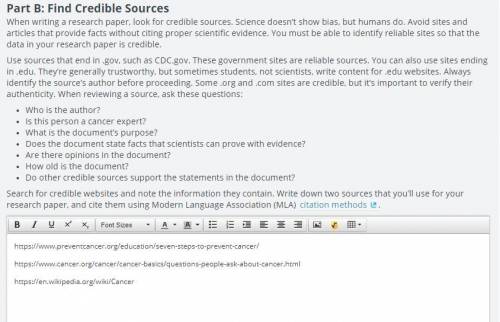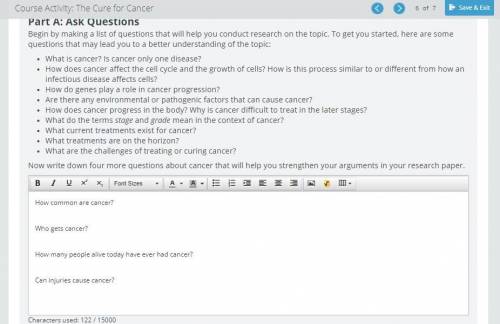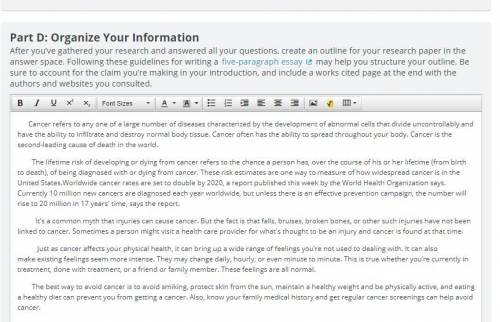
Health, 17.11.2020 04:20 Savagepanda911
Part A: Ask Questions
Begin by making a list of questions that will help you conduct research on the topic. To get you started, here are some questions that may lead you to a better understanding of the topic:
What is cancer? Is cancer only one disease?
How does cancer affect the cell cycle and the growth of cells? How is this process similar to or different from how an infectious disease affects cells?
How do genes play a role in cancer progression?
Are there any environmental or pathogenic factors that can cause cancer?
How does cancer progress in the body? Why is cancer difficult to treat in the later stages?
What do the terms stage and grade mean in the context of cancer?
What current treatments exist for cancer?
What treatments are on the horizon?
What are the challenges of treating or curing cancer?
Now write down four more questions about cancer that will help you strengthen your arguments in your research paper.
Part B: Find Credible Sources
When writing a research paper, look for credible sources. Science doesn’t show bias, but humans do. Avoid sites and articles that provide facts without citing proper scientific evidence. You must be able to identify reliable sites so that the data in your research paper is credible.
Use sources that end in .gov, such as CDC. gov. These government sites are reliable sources. You can also use sites ending in .edu. They’re generally trustworthy, but sometimes students, not scientists, write content for .edu websites. Always identify the source’s author before proceeding. Some .org and .com sites are credible, but it’s important to verify their authenticity. When reviewing a source, ask these questions:
Who is the author?
Is this person a cancer expert?
What is the document’s purpose?
Does the document state facts that scientists can prove with evidence?
Are there opinions in the document?
How old is the document?
Do other credible sources support the statements in the document?
Search for credible websites and note the information they contain. Write down two sources that you’ll use for your research paper, and cite them using Modern Language Association (MLA) citation methods.
Part C: Take Notes
In a separate location, take notes from the sources you have identified. The notes will provide details for your paper. While taking notes from texts and websites, use these reading strategies. In the space provided, write four pieces of information that you intend to use in your paper.
Part D: Organize Your Information
After you’ve gathered your research and answered all your questions, create an outline for your research paper in the answer space. Following these guidelines for writing a five-paragraph essay may help you structure your outline. Be sure to account for the claim you’re making in your introduction, and include a works cited page at the end with the authors and websites you consulted.
Part E: Write Your Paper
Write your research using your outline and the research you’ve collected. Be sure to proofread and revise your writing to catch any errors in grammar, spelling, logic, or cohesion. Remember that you must add a works cited page at the end of your paper to give credit to your sources.
When you have completed your paper, submit it to your teacher along with this activity.
PLEASE ANSWER BY 11/30

Answers: 3


Another question on Health

Health, 21.06.2019 23:00
An 81-year-old man and avid reader had a mild stroke from which he eventually recovered. he did have some residual signs and symptoms, however, such as: - right-sided homonymous hemianopia (i.e. loss of vision on the right half of the visual field in each eye) - alexia ("dyslexia"), the inability to read, which greatly frustrated this man - loss of sensation on the skin on the right side of the body why was this man unable to see the right half of his field of vision?
Answers: 3

Health, 22.06.2019 12:20
Once an action plan is in place, it should not be changed.w select the best answer from the choices provided.truefalse
Answers: 2


Health, 23.06.2019 05:00
An 80-year-old woman comes to the urgent care clinic with dyspnoea on exertion. on physical examination, her blood pressure is 100/70, and her pulse is 75. she has no pulsus paradoxus. her jugular veins are distended, and she has distant heart sounds. in addition, she has extra third and fourth heart sounds. her liver is enlarged, and she has pedal oedema. she has occasional premature ventricular contractions on her electrocardiogram. a chest x-ray reveals clear lung fields with a dilated cardiac silhouette. her echocardiogram reveals ventricular walls with a "speckled pattern". which of the following is the most likely diagnosis? - alcoholic cardiomyopathy- amyloidosis- haemochromatosis- tuberculosis- viral myocarditis
Answers: 1
You know the right answer?
Part A: Ask Questions
Begin by making a list of questions that will help you conduct research on th...
Questions

Social Studies, 12.10.2020 19:01



History, 12.10.2020 19:01


Mathematics, 12.10.2020 19:01



Mathematics, 12.10.2020 19:01



Computers and Technology, 12.10.2020 19:01


Physics, 12.10.2020 19:01


Mathematics, 12.10.2020 19:01



Mathematics, 12.10.2020 19:01

History, 12.10.2020 19:01






